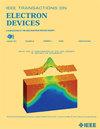采用门控多探针的InGaZnO双栅tft的量子力学分析
IF 3.2
2区 工程技术
Q2 ENGINEERING, ELECTRICAL & ELECTRONIC
引用次数: 0
摘要
结合极薄有源层薄膜晶体管的量子力学分析理论,采用门控-多探针方法分析了双栅a- igzo薄膜晶体管有源层中的通道电位分布。从GMP方法来看,在线性区域运行的情况下,通道电位分布遵循传统的从源极到漏极的渐变通道近似规则。在饱和区,观察到挤压和空间电荷限制区的形成。为了与量子力学理论进行比较,采用经典和量子力学方法对Silvaco公司的ATLAS设备进行了模拟。当采用量子力学密度梯度方法时,双栅偏置(DGB)模式的寄生电阻值与经典方法不同,这是由于顶栅和底栅通道电子的电流扩展路径相同。利用延长应力结果证实了量子理论的准确性,表明在考虑量子力学通道电子分布的情况下,通道中部附近缺陷的产生是导致偏置应力不稳定的主要机制。本文章由计算机程序翻译,如有差异,请以英文原文为准。
Quantum Mechanical Analysis of Dual-Gate InGaZnO TFTs Employing a Gated-Multiprobe
The channel potential distribution of the dual-gate a-IGZO thin-film transistors (TFTs) was analyzed in the active layer using a gated-multiprobe method (GMP method) combining theory of quantum mechanics for the analysis of TFTs having very thin active layer. From the GMP method, the channel potential distribution follows the conventional gradual channel approximation rule from the source to the drain electrodes in case of linear region operation. In the saturation region, pinch-off with the formation of a space-charge-limited region was observed. To compare the result with the theory of quantum mechanics, ATLAS from Silvaco Inc. (ATLAS) device simulation was performed using both classical and quantum mechanical approach. The resulting parasitic resistance values of the dual-gate biasing (DGB) mode differed from the classical approach, owing to the same current spreading path of the top- and bottom-gate channel electrons, when the quantum mechanical density gradient method was applied. The accuracy of the quantum theory was confirmed using the prolonged stress results, which indicated defect creation near the middle of the channel region was the dominant mechanism for the bias stress instability, considering quantum mechanical channel electron distribution.
求助全文
通过发布文献求助,成功后即可免费获取论文全文。
去求助
来源期刊

IEEE Transactions on Electron Devices
工程技术-工程:电子与电气
CiteScore
5.80
自引率
16.10%
发文量
937
审稿时长
3.8 months
期刊介绍:
IEEE Transactions on Electron Devices publishes original and significant contributions relating to the theory, modeling, design, performance and reliability of electron and ion integrated circuit devices and interconnects, involving insulators, metals, organic materials, micro-plasmas, semiconductors, quantum-effect structures, vacuum devices, and emerging materials with applications in bioelectronics, biomedical electronics, computation, communications, displays, microelectromechanics, imaging, micro-actuators, nanoelectronics, optoelectronics, photovoltaics, power ICs and micro-sensors. Tutorial and review papers on these subjects are also published and occasional special issues appear to present a collection of papers which treat particular areas in more depth and breadth.
 求助内容:
求助内容: 应助结果提醒方式:
应助结果提醒方式:


